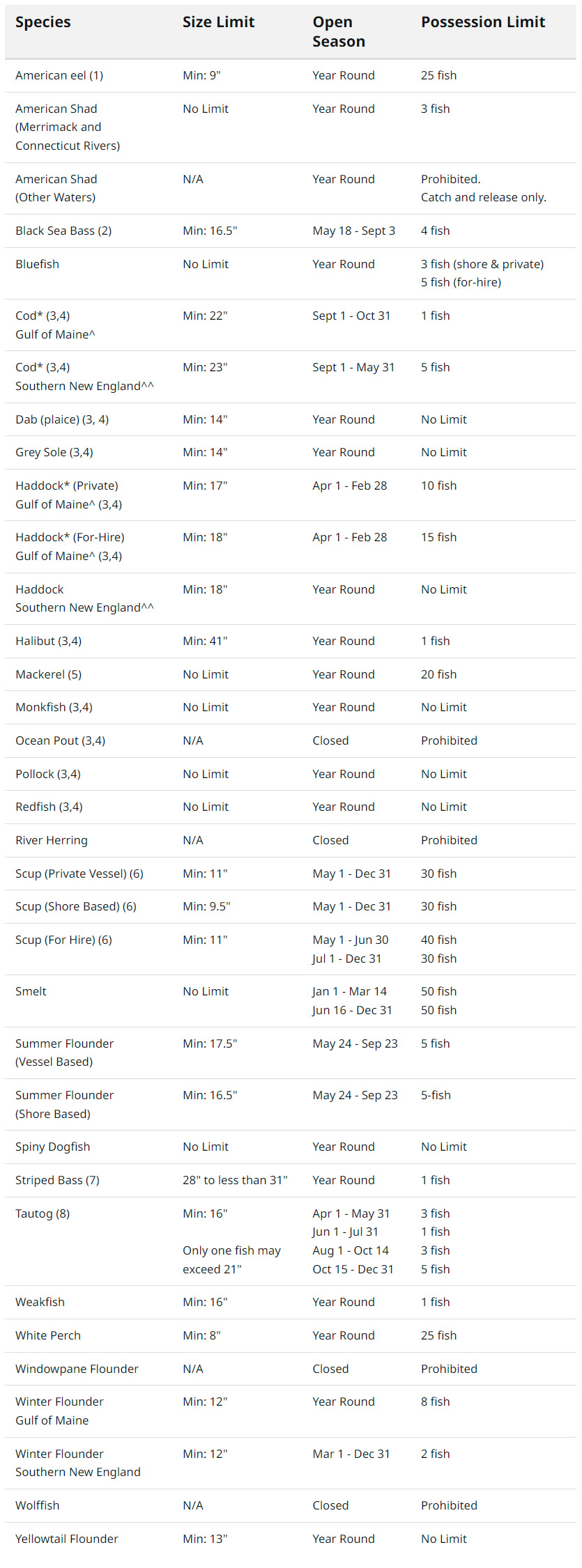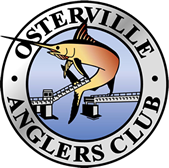MA Fishing Regulations
Division of Marine Fisheries makes every attempt to keep these regulations tables accurate and up to date. This is an “unofficial” copy. The Secretary of State maintains the official copy of the 322 CMR. You can buy an official copy from the state bookstore. For more information on ordering a copy of 322 CMR visit the Secretary of State website.

For any dates not listed in the “Season” column, the recreational fishery is closed. During closed seasons, retention, possession, and landing is prohibited and and all catch must be released.
Tunas, billfish, and swordfish are managed by NOAA’s Highly Migratory Species Office. Please consult NOAA Fisheries for permitting requirements and regulations.
* Rules are subject to change for May 2024. For more information on black sea bass, scup, and summer flounder, please see this Advisory.
^Gulf of Maine refers to all waters north of Cape Cod, including Cape Cod Bay, and those waters east of Cape Cod that are north of 42°00’N latitude.
^^Southern New England refers to all waters south and west of Cape Cod, including Nantucket Sound, Vineyard Sound, Buzzards Bay and Mount Hope Bay, and all waters east of Cape Cod that are south of 42°00’N latitude including Nauset Harbor and Pleasant Bay.
1) Subject to regulation by the Division and the municipality. Please consult municipal regulations.
2) Black sea bass are measured from the tip of the snout or jaw (mouth closed) to the farthest extremity of the tail, not including the tail filament. Black sea bass may be filleted but not skinned while at-sea. No more than two fillets per allowed fish may be possessed.
3) Federal rules apply beyond state waters. Consult NOAA Fisheries for regulations.
4) It is unlawful to fish with hook and line gear in the Winter Cod Conservation Closure from November 15 through January 31. It is unlawful to take cod from the Spring Cod Conservation Closure from April 16 through July 21. See maps in 322 CMR 8.07 for more details.
5) The mackerel limit applies as a daily per angler harvest limit and a per angler possession limit while fishing. It does not apply to holding mackerel in a freezer, fish car, holding car, or shore-based bait well.
6) Scup may be filleted but not skinned while at-sea. No more than two fillets per allowed fish may be possessed. If 5 or more anglers are onboard a private vessel, there is a vessel limit of 150-fish.
7) Striped bass are measured from the tip of the snout or jaw (mouth closed) to the farthest extremity of the tail. The discard of dead legal sized striped bass is unlawful.
The practice of high-grading, whereby legal sized striped bass are released in favor of larger fish caught subsequently is unlawful. Accordingly, it is also unlawful to keep a striped bass alive in water by attaching a line or chain to the fish (stringer), or placing it in a live well or holding car.
Striped bass retained by recreational shore or private vessel anglers are to be kept whole—except for evisceration, bleeding, or descaling—while on the waters of this state or any adjacent parcel of land, structure, portion of roadway, or parking lot. An exception is granted for striped bass being prepared for immediate consumption, such as on the private vessel or at the shore-side campground from which a fish was caught.
For-hire operators or crew may fillet striped bass for their patrons at any time during the for-hire trip prior to the patrons departing the vessel, provided: (1) the racks are retained in a manner that does not interfere with species identification or total length measurement until such time as the vessel has docked and all customers from that trip have departed the vessel and the racks may subsequently be disposed of in any legal manner; (2) at least two square inches of skin is left intact and no more than two fillets, representing the equivalent of one fish, may be possessed by each customer.
All recreational anglers are required to use inline circle hooks when fishing for striped bass with whole or cut natural baits, except when fishing with a natural bait attached to an artificial lure (e.g., tube and worm).The use non-lethal devices to remove striped bass from the water is required; gaffing striped bass is prohibited.
8) When the tautog fishery is open, private anglers are subject to 10-fish maximum tautog limit for the vessel. The most restrictive limit of the per angler bag limit or per vessel maximum limit applies. During any open season an angler may retain, possess, and land one trophy fish exceeding the 21″ maximum size per calendar day.
